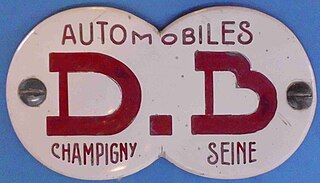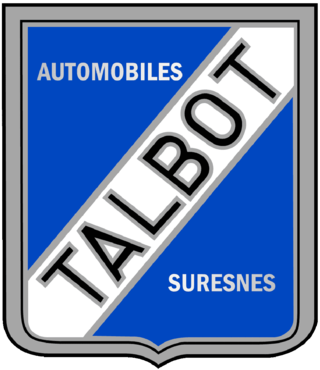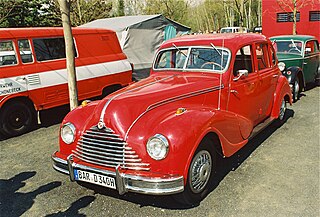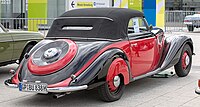
Deutsch-Bonnet (DB), is a brand of sports cars created in 1937 by Charles Deutsch and René Bonnet and disappeared in 1962.

The BMW 328 was a sports car produced by BMW from 1936 to 1940. Its body design is credited to Peter Szymanowski, who became BMW chief of design after World War II.

Dixi is a brand name of cars made by originally by Automobilwerk Eisenach, later by BMW. The first Dixi car was produced in 1904. In the difficult economic climate of the 1920s the company found it hard to sell its 6/24 and 9/40 models. So the manufacturer decided to enter the small car market, and in 1927 signed a licensing agreement with the Austin Motor Company to build a variant of the Austin 7. A production level of 2000 cars a year was agreed upon, and Dixi paid Austin a royalty on each vehicle produced.

The Triumph Motor Company was a British car and motor manufacturing company in the 19th and 20th centuries. The marque had its origins in 1885 when Siegfried Bettmann of Nuremberg formed S. Bettmann & Co. and started importing bicycles from Europe and selling them under his own trade name in London. The trade name became "Triumph" the following year, and in 1887 Bettmann was joined by a partner, Moritz Schulte, also from Germany. In 1889, the businessmen started producing their own bicycles in Coventry, England.

Talbot-Lago was a French automobile manufacturer based in Suresnes, Hauts de Seine, outside Paris. The company was owned and managed by Antonio Lago, an Italian engineer that acquired rights to the Talbot brand name after the demise of Darracq London's subsidiary Automobiles Talbot France in 1936.

Eisenacher Motorenwerk (EMW) was an East German manufacturer of automobiles and motorcycles based in Eisenach. EMW also entered Formula One as a constructor in 1953, but participated in only one race, the 1953 German Grand Prix. The car retired after 12 laps with exhaust problems.

Industrieverband Fahrzeugbau, usually abbreviated as IFA, was a conglomerate and a union of companies for vehicle construction in the former East Germany.
The Automobilwerk Eisenach (AWE) was an automobile manufacturer in Eisenach, Germany.

The official founding date of the German motor vehicle manufacturer BMW is 7 March 1916, when an aircraft producer called Bayerische Flugzeugwerke was established. This company was renamed to Bayerische Motoren Werke (BMW) in 1922. However, the BMW name dates back to 1917, when Rapp Motorenwerke changed its name to Bayerische Motoren Werke. BMW's first product was a straight-six aircraft engine called the BMW IIIa. Following the end of World War I, BMW remained in business by producing motorcycle engines, farm equipment, household items and railway brakes.

The BMW 501 was a luxury car manufactured by BMW from 1952 to 1958. Introduced at the first Frankfurt Motor Show in 1951, the 501 was the first BMW model to be manufactured and sold after the Second World War, and as the first BMW car built in Bavaria. The 501 and its derivatives, including the V8 powered BMW 502, were nicknamed “Baroque Angels” by the German public. The BMW 502 was the first postwar German car to be manufactured with a V8 engine.

The BMW 326 is a medium-sized sedan produced by BMW between 1936 and 1941, and again briefly, under Soviet control, after 1945. The 326 was BMW's first four-door sedan. It had an innovative design and sold well despite its relatively high price. It also had an unusually involved afterlife.

The BMW 335 is a six-cylinder sports sedan produced by the Bavarian firm BMW between 1939 and 1941.

The BMW 340, subsequently rebadged as the EMW 340, is a large six-cylinder four-door passenger saloon produced at Eisenach initially in the name of BMW. Five-door 340 station wagons were also manufactured. It was described in 1948 as the first new car model produced in Germany after the war: despite new body panels, under the skin it was a modified version of the BMW 326 with which it shared its engine and wheelbase, and which had originally been commercialised in 1936. The 326 had nevertheless been an innovative and well regarded product and the 340, which incorporated several improvements, was seen as a desirable car well into the 1950s. Early years were dogged by disputes centred on ownership of the plant where it was assembled and its manufacturers’ rights to use the BMW name. The cars later appeared badged as EMW 340s, and it was under this name that 340s continued to be sold until at least 1953.

The BMW 321 is a compact six-cylinder automobile produced by the Bavarian firm between 1938 and 1941. After 1945, production of the 321 resumed at the Eisenach plant and continued until 1950.

The IFA F9, subsequently rebadged as the EMW 309, is a compact saloon manufactured under the auspices of the Russian and East German states between 1949 or 1950 and 1956. It was initially built at Zwickau at the plant previously owned by Auto Union. In 1953 production was transferred to the EMW, former BMW manufacturing plant at Eisenach under the name EMW 309 until 1956 where its underpinnings subsequently found their way into the Wartburg 311.

The DKW F8 is a compact front-wheel drive two-stroke engined saloon, introduced in 1939. The F8 was slightly shorter than its predecessor despite having a marginally increased wheelbase. The base model, known as the Reichsklasse, was manufactured only till 1940 but the Meisterklasse sedan continued in production until 1942. In addition to the saloons, cabriolet versions were offered.

The automotive industry in Germany, is one of the largest employers in the world, with a labor force of over 857,336 (2016) working in the industry.

The Wartburg 311 is a car produced by East German car manufacturer VEB Automobilwerk Eisenach from 1956 to 1965. The 311 model was manufactured in a number of variations, including pickup, sedan, limousine, coupé, and as a two-seat roadster. The two-stroke engine was enlarged to 992 cc in 1962. An interim model, called the Wartburg 312 and featuring the chassis developed for the succeeding 353, was built from 1965 until 1967.

The Glas GT is a sports coupé produced by Hans Glas GmbH at Dingolfing. The car was first presented as the Glas 1300 GT in September 1963 at the Frankfurt Motor Show, with volume production starting in March 1964. The much rarer cabriolet version appeared in May 1965 and a larger engined 1700 GT in May 1965.

The BMW 02 Series is a range of sporty compact executive cars produced by German automaker BMW between 1966 and 1977, based on a shortened version of the New Class Sedans.


























